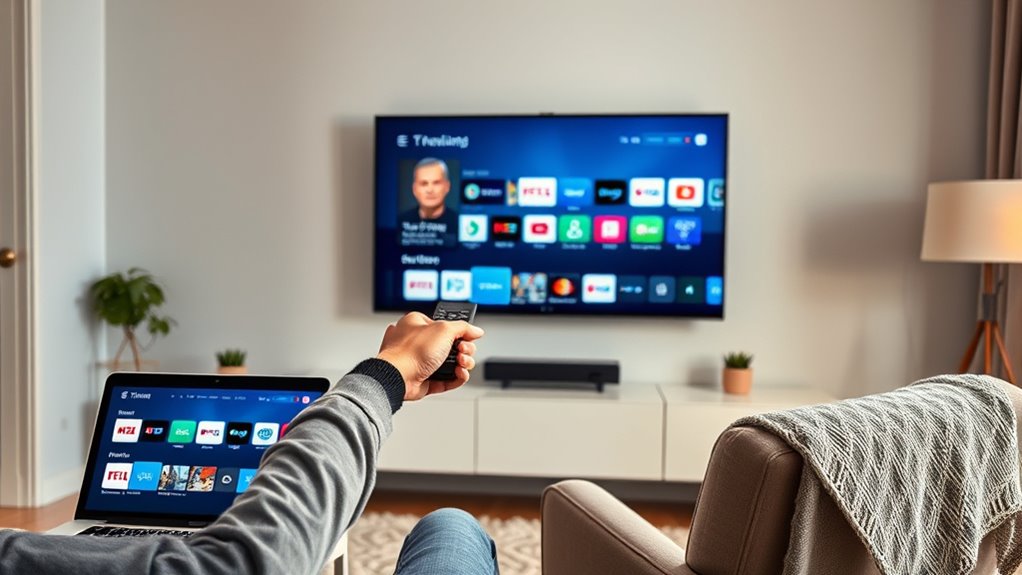To understand streaming services and cut the cord, start by exploring popular platforms like Netflix, Hulu, and Amazon Prime, which offer a wide range of content at lower costs than cable. Focus on the services that match your viewing preferences and consider creating a budget to manage your expenses. With faster internet and personalized options, streaming makes entertainment flexible and affordable. Keep exploring to discover tips that help you make the switch smoothly.
Key Takeaways
- Compare streaming platforms’ content, prices, and features to choose those that best fit your viewing preferences and budget.
- Create a streaming budget to manage costs and avoid overspending amid multiple service subscriptions.
- Focus on select platforms instead of subscribing to all, reducing content overload and simplifying your viewing experience.
- Use devices with fast internet to ensure smooth streaming and improve overall user experience.
- Stay informed about new features and plans from traditional providers adapting to streaming trends for flexible options.

In recent years, more households are choosing to cut the cord and switch to streaming services, driven by the high costs of traditional cable TV. You’ve likely noticed the rising bills—many pay over $200 a month for cable, which is more than twice what most streaming services cost. This cost difference motivates a lot of people to explore streaming as a more affordable alternative. By 2026, experts project that over 80 million U.S. households will have dropped cable entirely, highlighting how widespread this trend has become. If you’re considering making the switch, understanding how streaming works and how to manage your costs can help you make a smooth transition.
Rising cable costs drive more households to switch to affordable streaming options by 2026.
The variety of streaming options is vast, with services like Netflix, Hulu, and Amazon Prime Video offering diverse content, from original series to blockbuster movies. For live TV, platforms such as Sling TV and Hulu with Live TV have become popular choices, providing access to news, sports, and network channels without traditional cable. YouTube TV stands out as the most-watched virtual multichannel video programming distributor, boasting nearly 8 million subscribers in 2023. The global subscription video on demand (SVOD) market is also expanding rapidly, expected to reach 1.68 billion subscriptions by 2027, indicating that more people are embracing streaming worldwide.
Cost is a significant reason why many switch. Streaming services are generally more affordable, allowing you to customize your package based on your preferences and budget. Many people create a streaming budget to avoid overspending, especially since the overload of content can sometimes be overwhelming. Still, the variety of choices means you can personalize your viewing experience with tailored recommendations and easy-to-navigate interfaces. Despite the abundance of options, some users find themselves overwhelmed by the content overload, but focusing on a few preferred platforms can streamline your experience. Additionally, the growth of Bitcoin runes and other innovative blockchain-based solutions could someday influence how digital content and subscriptions are managed securely.
The financial benefits are clear—paying for streaming typically costs less than traditional cable, which has seen revenue decline from over $100 billion in 2017 to less than $86 billion in 2022. Many users appreciate the flexibility and savings, but some are concerned about increasing subscription costs. A small percentage of cord-cutters, around 22%, have even returned to cable, often due to price hikes or content availability issues. Still, millions of others remain loyal to streaming, and traditional providers are adapting by offering more flexible plans and hybrid options.
As technology improves with faster internet and better streaming devices, the experience continues to get better. The growth of global SVOD subscriptions and innovations in streaming tech suggest that cutting the cord is likely to remain a popular choice. If you want to save money and enjoy personalized content, understanding these trends and options will help you navigate your transition from traditional TV to streaming services confidently.
Frequently Asked Questions
How Do I Choose the Best Streaming Service for My Needs?
When choosing the best streaming service for your needs, start by evaluating your content preferences, like movies, shows, or live sports. Consider your budget and device compatibility to find options that fit both your wallet and tech setup. Look into features like DVR, ad-free viewing, and picture quality. Read reviews and try free trials to test user experience. This way, you’ll pick a service that offers the right content and value for you.
Can I Combine Multiple Streaming Services Without Extra Costs?
You can combine multiple streaming services without extra costs by choosing bundles and promotional offers. For example, signing up for Disney+, Hulu, and ESPN+ in a bundle can save you money compared to subscribing separately. Look for discounts, free trials, and ad-supported options that offer access to multiple platforms at a lower price. Just be aware that some bundles might require a single payment or specific package, so check the details carefully.
What Devices Are Compatible With Popular Streaming Platforms?
Imagine your TV as a bustling city hub, ready to connect you to countless destinations. Your device is the vehicle that takes you there. Devices like Amazon Fire TV, Roku, Apple TV, Chromecast, and Android TV act as versatile cars, compatible with popular platforms like Netflix, Hulu, Disney+, and YouTube. They open the roads to endless streaming adventures, making sure you reach every entertainment destination with ease.
How Do I Handle Regional Restrictions on Streaming Content?
When you face regional restrictions on streaming content, you can use tools like VPNs or Smart DNS services to bypass them. A VPN masks your location by routing your traffic through servers in other countries, gaining access to blocked libraries. Just remember, using these methods might violate platform terms of service and legal rules, so weigh the risks carefully. Keep in mind, some services actively block VPN traffic, which may require you to find reliable solutions.
Are There Legal Considerations When Canceling Cable Contracts?
Imagine holding a contract in your hands, its words like a maze. When you cancel your cable, you must follow legal rules that protect you, like providing written notice or citing specific laws. Be aware of early termination fees, state protections, and special circumstances like military orders. Staying informed keeps you in control, ensuring you can switch off with confidence and avoid unexpected charges or legal trouble.
Conclusion
Remember, sometimes you have to cut the cord to truly enjoy the show. By exploring different streaming options and staying savvy about deals, you can save money and tailor your entertainment to your tastes. Don’t be afraid to switch things up—flexibility is key. After all, the best way to get what you want is to take control. So go ahead, make the leap, and watch your favorites without breaking the bank.










